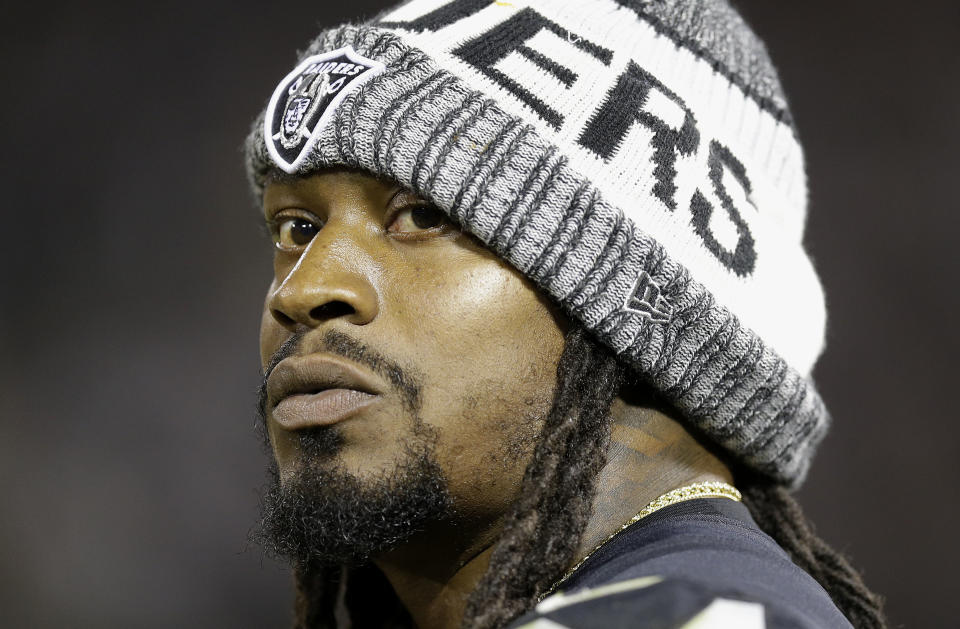Juggernaut Index, No. 10: Raiders add Beast Mode to loaded fantasy roster

For most of us, the NFL is really a more entertaining league when A) Marshawn Lynch is involved and B) the Oakland Raiders are good. The league is also better when the Oakland Raiders play their home games in Oakland, but that’s a problem for 2019. At the moment, this team is where it belongs and coming off a 12-win season. Beast Mode is back in our lives, too. Good times.
[Now’s the time to sign up for Fantasy Football! Join for free]
Oakland broke a 13-year playoff drought in 2016 and then signed quarterback Derek Carr to the richest deal in history, so we can no longer think of the Raiders as some up-and-coming team that might break through. The silver and black has re-arrived. This is a damn good roster. Oakland is no lock to repeat last year’s win total — the Raiders’ point differential was a modest +31 in 2016 — but there’s little question this team will be a rough matchup for everyone.
Carr earned a nine-figure contract in reality. What’s he worth in fantasy?
Carr is still only 26 years old, he’s earned Pro Bowl recognition in each of the past two seasons and he’s clearly an ascending talent. He had a sloppy rookie campaign, but that’s the norm. Here’s a partial list of key stats in which Carr has improved each year since entering the league: completion percentage, yards per game, adjusted yards per attempt, interception rate, passer rating and net yards per attempt. And, of course, winning percentage. He can play. Carr directed seven game-winning drives last season, the second highest total in the league behind Matthew Stafford’s eight. He also has one of the lowest all-time career interception rates, for what it’s worth.
The decision to lock up Carr through 2022 was a relatively easy call for the Raiders. He’s terrific, and the team retained flexibility enough to re-sign other young stars. Carr suffered a fractured fibula late last season, bringing an abrupt end to any hopes fans may have had about a deep playoff run. But he was fully recovered by April, and he just went 7-for-9 with two TD passes against the Rams in preseason play. There’s no reason to downgrade him due to health concerns. All is well. Carr has thrown 60 touchdown passes over the past two seasons, he’s protected by an excellent O-line, and his bookend receivers are among the game’s best. Draft him as a fantasy starter in leagues of standard size. Carr is going 30-35 picks later than Jameis Winston in typical drafts, but projections for each player should be extremely similar.

Amari Cooper looks to make a third-year leap.
Cooper just turned 23 in June and he’s already produced back-to-back 70-catch, 1000-yard seasons. Like Carr, Cooper shouldn’t be considered a finished product, so it’s easy to imagine a jump in production. But at the spot he’s typically drafted (ADP 24.6, WR11), we don’t want to assume an increase in value is forthcoming. Thus far, the glaring hole in Cooper’s fantasy game has been his lack of touchdowns, which follows naturally from his limited red-zone opportunities. He saw only 13 red-zone targets last season and eight the year before. He’s seen just seven chances inside the 10-yard line over two years.
If Cooper is ever going to crack the top-10 fantasy scorers at his position, he’ll obviously need to emerge as a target magnet near the goal-line. Carr talked up Cooper with enthusiasm over the summer…
“That dog in [Cooper] is coming out,” Carr said. “That thing you saw at Alabama where he’d just take games over. Not to say that he hasn’t because he has, but I think it’s not just becoming a thing of, ‘What game is it going to be?’ It’s becoming a thing of, ‘That’s who he is.’ [Defensive backs] better know that he’s really taking it serious, that he’s trying to go attack them this year. He’s not going to let them come to him this year. That just comes with age.”
…and, again, he’s only 23. We likely haven’t seen his best. But for now, Cooper isn’t yet the No. 1 option for this team in the most important area of the field.
[Pick one winner a week. Play Survival Football for chance at $100K]
That guy, of course, is veteran Michael Crabtree. He drew 21 red-zone targets last year, ranking sixth in the NFL, and he’s seen twice as many inside-the-10 chances as Cooper over the past two seasons. Crabtree actually outscored Cooper in fantasy in both 2015 and 2016, and he out-targeted Amari, too.
Still, Crabtree is getting selected more than two full rounds after Cooper in drafts. No matter what you think about the trajectories of these two players, it’s tough not to prefer Crabtree’s price. I’m with Loza on this debate.
Seth Roberts remains the No. 3 receiver for the Raiders, with free agent add Cordarrelle Patterson likely to fill a gadgety cameo role. You can ignore both players in standard fantasy formats. Patterson is clearly a player of interest if your league scores for return yards.
Jared Cook tops the depth chart at tight end, but that hasn’t been a heavily targeted position for the Raiders in recent years. Cook established himself long ago as an overhyped, underproductive player who deserves consideration only in leagues in which you start multiple TEs.
Beast Mode, back in our fantasy lives.
Setting aside fantasy considerations for just a sec, this is pretty awesome. Lynch is endlessly entertaining, an Oakland native, and this just feels like a perfect match between player and city. At some level this is all supposed to be a game, which means it’s supposed to be fun. Lynch is a party. It’s so good to have him back.
That said, Lynch is also 31. He wasn’t an active player at 30. He began to break down physically at 29, when he was limited to seven games and averaged 3.8 yards per carry. We can’t view him as any sort of lock to deliver a vintage season. Sorry.
The good news is that the Raiders don’t seem determined to feed him the ball a zillion times, because the team obviously wants him operating at full capacity in December and beyond. Local writers have projected a workload similar to what Latavius Murray handled last year (195 carries, 33 receptions), and that would almost certainly be enough to deliver a useful fantasy season. Murray converted those 228 touches into 1052 scrimmage yards and 12 TDs. He dominated touches in goal-to-go situations for Oakland, carrying 26 times inside the 10-yard line and 17 times inside the 5. Assuming similar usage for Lynch — and assuming he plays, say, 13-14 games — he has a clean path to double-digit touchdowns. He’ll do his running behind an outstanding line, so he’s a good bet to average better than Murray’s 4.0 YPC.
Considering Lynch’s age and history, as well as the quality of his backups, the Oakland backfield is the rare situation in which a strategic handcuff makes good sense. DeAndre Washington averaged 5.4 YPC on 87 attempts last season and Jalen Richard averaged 5.9 on 83. Washington has been running ahead of Richard in the preseason; Richard is listed ahead of Washington on the team’s official depth chart. Take your pick. Both backs are 5-foot-8 and roughly 205 pounds. Washington has better timed speed, but Richard was as slippery as any running back in the NFL last season. I’ve given a slight edge to Richard in the ranks; in all likelihood, he and Washington would run in committee if Lynch misses time.
Oakland’s D, approved for streaming.
Khalil Mack is a nightmare, a disruptive force, the reigning NFL Defensive Player of the Year. Just look at this dude…
Khalil Mack fights through two TEs for the sack pic.twitter.com/ifEhYPwp37
— Josh Norris (@JoshNorris) August 20, 2017
But despite the fact that Mack finished the season with 11.0 sacks, Oakland only registered 25 as a team, the lowest total in the league. This defense also ranked No. 30 in yards allowed per pass attempt (7.9) and No. 25 in yards per carry (4.5). The Raiders addressed the D in a big way during the draft, but there’s no reason to view this group as more than a streaming option for fantasy purposes. Three of Oakland’s first four games are on the road against respectable teams (Ten, Was, Den), but we’ll be adding this defense for the Jets matchup in Week 2.
2016 Offensive Stats & Ranks
Points per game – 26.1 (6)
Pass YPG – 253.2 (13)
Rush YPG – 120.1 (6)
Yards per play – 5.5 (15)
Plays per game – 65.7 (10)
—
Previous Juggernaut Index entries: 32) NY Jets, 31) San Francisco, 30) Cleveland, 29) LA Rams, 28) Baltimore, 27) Chicago, 26) Minnesota, 25) Detroit, 24) Denver, 23) Jacksonville, 22) Buffalo, 21) Philadelphia, 20) Miami, 19) Indianapolis, 18) Kansas City, 17) Washington, 16) NY Giants, 15) Tennessee, 14) LA Chargers, 13) Carolina, 12) Houston, 11) Arizona, 10) Oakland


